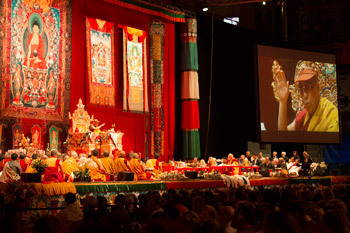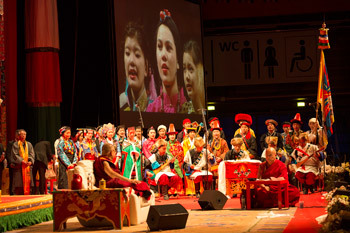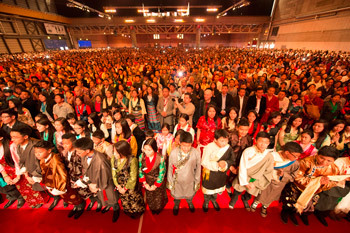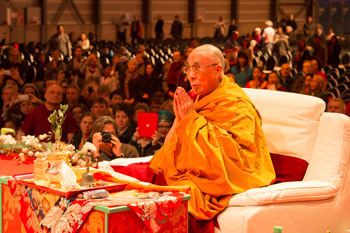Fribourg, Switzerland, 14 April 2013 - The sun glancing across Lake Morat outside His Holiness the Dalai Lama’s hotel this morning gently caught the newly opening leaves on trees on the shore; signs of the coming of spring on a day when he was to give a White Tara Long Life empowerment. He drove to the Fribourg Forum early to begin preparations. Those done, he was about to pick up the text where he had left off yesterday, but seeing that people were still arriving decided to talk about something else.
“At an inter-faith meeting in Amritsar, India, some years ago, a Sufi master declared that there are three questions that characterize religious traditions: What is the self? Has it a beginning? And has it an end?”
With regard to ‘What is the self?’ according to other religions there is an unchanging soul, but the Buddha says the notion of ‘I’ is a deceptive mind. We have a notion that there is a self governing the psycho-physical aggregates of which we consist, but the Buddha says there is nothing like that. He says that just as a chariot is designated on the basis of its parts, so is the ‘self’ designated on the basis of the aggregates.
As to whether the self has a beginning, theists say self comes into being during god’s creation, so it has a beginning. Non-theists like Buddhists say there is no creator god and that if we examine the aggregates we need to establish whether mind of consciousness has a beginning. Since Buddhism asserts that for something to arise requires an immediately preceding condition that is a congruent cause, consciousness has no beginning. Therefore the self designated on the basis of it has no beginning either.
The question, ‘Has self an end?’ relates to past and future lives. We talk about past lives because mind has no beginning. As to the future, theists talk about heaven and hell, but present no detailed analysis of the matter. As human beings we have a consciousness dependent on our brains, but closer examination reveals subtler levels of consciousness not so dependent. Evidence of this is indicated in the cases of Buddhist practitioners who remain in posthumous meditative equipoise when they are considered to be clinically dead. His Holiness mentioned a case he’s heard about recently that took place in Tibet and of the 20 or so recorded cases in the Tibetan exile community; he mentioned his Senior Tutor, Ling Rinpoche and the 100th Ganden Throne-holder. Since science has no explanation of this phenomenon, we may accept the Buddhist account that while subtle consciousness remains there the body remains fresh, despite the heart’s ceasing to beat. The conclusion is that there is no beginning or end to consciousness, nor of the self associated with it.
 |
| His Holiness the Dalai during the teachings at the
Forum Fribourg at Fribourg, Switzerland, on April 14, 2013. Photo/Manuel
Bauer |
The ‘Lamp for the Path’ refers to persons only intent on higher rebirth as of low capacity. Those who practise the three higher trainings and the 37 wings of enlightenment intent on liberation are of middling capacity. When you wish to achieve enlightenment in order to benefit others, you become a person of great capacity. His Holiness remarked that when we are cultivating the awakening mind, it is good to combine the sevenfold cause and effect method with that of exchanging self with others. The text discusses the aspiring awakening mind, the way to take the Bodhisattva vows and the subsequent Bodhisattva practices of the six perfections: generosity, morality, patience, effort, concentration and wisdom.
He explained that we can employ any object to cultivate concentration, but for beginners like us, the breath is useful and appropriate. We can observe our inhalation and exhalation, just as they do in the Thai and Burmese traditions. The antidote to the disturbing emotions is wisdom understanding emptiness, seeing things as they are. The Madhyamaka argument is that because things arise as a result of causes and conditions, they have no independent existence. They are instead dependently designated. Towards the end of the text, His Holiness pointed out that in tantra there are techniques for gaining concentration and insight together.
Regarding the White Tara empowerment he was about to give, he said it belongs to secret mantra. Secret refers to the Buddha’s not having taught this openly in public, but only to a select group of disciples having arisen as the lord of the mandala. Likewise tantra has to be practised secretly. Deity yoga is done in the context of understanding emptiness. You have to employ your own mind, your understanding of emptiness, while being aware of the symbolism involved. The word mantra refers to protecting the mind. Protecting it from ordinary appearances and clinging to them. Since tantra is a path that leads to Buddhahood quickly, it is called a vehicle - hence it is known as the ‘secret mantra vajrayana.’
His Holiness went on to give a White Tara empowerment that was taken from the visionary teachings of the Fifth Dalai Lama.

|
| Tibetan singers and musicians perform before His Holiness the Dalai Lama'a public talk on "Secular Ethics" at the Forum Fribourg at Fribourg, Switzerland, on April 14, 2013. Photo/Manuel Bauer |
After lunch he began a talk on Secular Ethics in his customary way.
“Dear brothers and sisters, I’m extremely happy to have this opportunity to talk to you. Please think of yourselves just as human beings, not as Swiss, Italian, Russian, German, French, Spanish or Tibetan. Every one of us wants to live a happy life and we all have a right to fulfil that goal. However, we face many problems because we insist on focussing on the secondary differences between us.”
He said he usually discusses secular ethics under three main points, of which the first is our common experience. We are all born from a mother’s womb and most of us grow up under her care. This is a biological source for our sense of affection. Our very survival depends on others’ care. Those of us who received the greatest affection when we were young tend to be happier later in life. Families bound together by affection tend to be happier.
The second point is that we all have the potential to develop a sense of concern for others. No matter how strong or how educated we are, we cannot survive without others, so how can we neglect their interests? Warm-heartedness and genuine concern for others earns friendship, on the basis of which we can act truthfully and transparently, which in turn is a source of confidence. Thirdly are scientific findings. Modern scientists are mostly concerned with matter and what they can measure. But today, increasing numbers of scientists are showing interest in the mind and emotions, concluding that a healthy mind favours sound physical health.
His Holiness asked:
“How can we promote secular ethics? Through education - for which we need a map of the mind. Please think about what I have said.”

|
His Holiness the Dalai Lama with the head of the Central Tibetan Administration Sikyong Dr Lobsang Sangay speaking to the Tibetan community the Forum Fribourg at Fribourg, Switzerland, on April 14, 2013. Photo/Manuel Bauer
|
Towards the end of the afternoon, His Holiness spoke to a gathering of Tibetans resident in Switzerland and the hall with a capacity of 8000 was filled once more. Accompanied by the Sikyong, Dr Lobsang Sangay, he was welcomed to the stage by a young Tibetan musical troupe. Everyone stood for the Tibetan national anthem and the Representative briefly presented a report. This was followed by children sweetly singing a patriotic song, after which His Holiness began his address:
“Tibetans, monks and nuns, young and old, settled here in Switzerland, I have come here for a short time to teach and meet with you.”
He said that Tibetans have kept alive the spirit that thrived when Tibetan kings ruled all Tibet in the 7th, 8th and 9th centuries. They have kept the Nalanda tradition of Buddhism alive as well as the Tibetan language, which is the best medium for giving it expression. He talked about the origins of the Tibetan nation and its culture, noting that archaeological estimates for the dates of the first Tibetans vary from 4000 years ago to 10,000 years ago. He recalled a Chinese archaeologist he met at Harvard telling him that contrary to Chinese government accounts, his findings suggested that Tibetans evolved on the Tibetan plateau itself, not elsewhere in China.
He reminded his listeners that Buddhism is not just about prayers and rituals, but using your mind to effect an inner transformation. He urged them to become twenty-first century Buddhists, using their own intelligence to understand what Buddhism is about.
He explained how his retirement came about; how he semi-retired in 2001 when a leader was first elected and how in 2011, he decided the time had come to hand over all political responsibility to the elected leadership. He said:

|
View of the more than 8000 members of the Tibetan community of Switzerland attending a meeting with His Holiness the Dalai Lama at the Forum Fribourg at Fribourg, Switzerland, on April 14, 2013. Photo/Manuel Bauer
|
“China has accused us of trying to restore the system as it used to be - but we are following democracy and they are not.”
He traced the evolution of the Middle Way approach, recalling that Tibet’s last appeal to the UNO in1965, after three UN resolutions, was still ineffective. Concluding that dialogue with China was the only option, the Middle Way approach began to evolve gradually from 1974 and the Chinese indicated some willingness to respond on several occasions since then. He emphasised that the Middle Way approach is based on non-violence. However, he also stressed that it had been made clear as early as 1954 that Tibetans did not consider themselves to be under China.
He assured the assembled Tibetans that the Sikyong would speak further about these important matters. Recollecting the honest, if innocent, impression the initial 1000 Tibetans had made when they first arrived in Switzerland so many years ago, His Holiness urged those living here today to continue to be careful to maintain their dignity and good reputation.

















